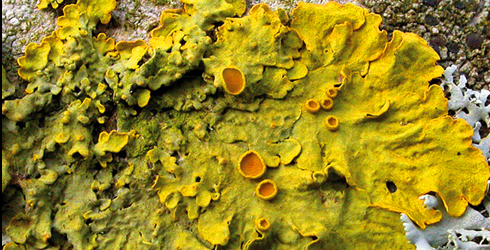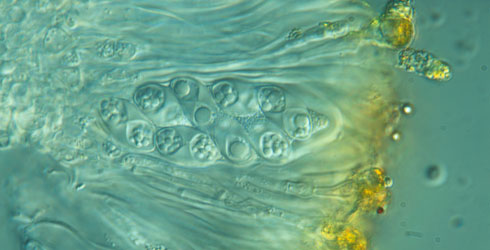Xanthoria parietina (golden shield lichen)
Watch the video to find out more about Xanthoria parietina and what lichens can tell you about pollution levels in your local environment.
Xanthoria parietina, the golden shield lichen, is a conspicuous yellow foliose lichen
This lichen is formed of two organisms living together symbiotically:
- A fungus which forms the body of the lichen, which in Xanthoria parietina consists of flattened spreading leaf-like lobes lobes and produces spores in the bright orange cups on the surface.
- A single-celled green alga which is protected by the fungus from extreme conditions of UV or drought by the yellow colour (parietin) which acts as a sunscreen. In return the alga provides the nutrients for the fungus through photosynthesis.
Xanthoria parietina is found in sunny, exposed places that are rich in nitrogen
- sea cliffs where seabirds provide nitrogen
- trees, rocks and manmade substrates wherever there is plenty of nitrogen
Xanthoria parietina is tolerant of high levels of nitrogen especially ammonia and is common on trees and buildings near farmland.
Xanthoria parietina can be used as a monitor for nitrogen in the atmosphere.
Species detail
-

Structure and taxonomy
Find out about the family that Xanthoria parietina belongs to and why the species is often found in sunny, exposed places.
-

Habitat, distribution and ecology
Discover where Xanthoria parietina and why it is rare in certain areas. Learn about the types of habitat that this species thrives in.
-

Reproduction
Learn about the reproductive patterns of golden shield lichen and the vital relationship it is thought to share with other lichens.
-

References
Get reference material for Xanthoria parietina.
Images

The yellow foliose lichen - Xanthoria parietina

Xanthoria parietina forms a conspicuous yellow band on sea cliffs where there are plenty of seabirds to provide the nitrogen that it loves.

Xanthoria parietina

Xanthoria parietina is formed of a fungus (forming the body) and a green chlorococcoid alga (which provides the nutrients for the fungus).
Author
Pat Wolseley
Scientific associate, Lichens, Department of Botany
Toolbox
Glossary
alga(e) - in lichens, single-celled or filamentous green organisms that contain chloroplasts.
foliose lichens - leaf-like lichens with spreading to upright flattened lobes that are attached to the twig from the lower surface of each lobe.
fungus (fungi) - spore-producing organism without chlorophyll.